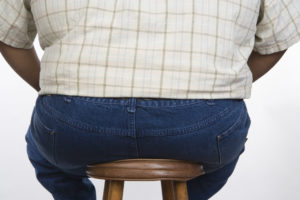
It’s a long-known fact that sitting for prolonged periods can increase your chances of developing everything from heart disease to cancer and diabetes, and can ultimately decrease your life expectancy. But there’s one side effect that you may not have realized is linked to sitting on your behind all day: Dead Butt Syndrome.
Yes, people are sitting for so long that their behinds are literally falling asleep. Also known as gluteal amnesia, dead butt syndrome is a condition that occurs when your gluteus medius gets inflamed and therefore, doesn’t function as it should.
Sitting for too long can restrict the blood flow, leading to hip pain, lower backache, and ankle problems. Essentially, this happens because our anuses are not designed to hold weight for long periods. Spending an exorbitant amount of time on your butt decreases your body’s ability to use your gluteus muscles when they’re actually needed.
People experiencing dead butt syndrome may feel the familiar sensation of a body part “falling asleep” or an uncomfortable tingling. ‘Paresthesia,’ an abnormal sensation felt in your body due to compression or irritation of nerves might vary from mild to severe and can be fleeting or long-lasting.
The main culprit is inactivity, so if you have a sedentary lifestyle, like sitting at a desk chair for long hours every day, chances are you’re more susceptible to experience Dead Butt Syndrome. Your behind tends to shut down due to lack of activity and stimulus. It also causes strain on other muscles and joints and forces weaker muscles to do the job of the stronger gluteus maximus.
If you don’t see your physician about this, it could lead to “synergistic dominance,” where the smaller helper muscles of the hip and leg are now taking over movement and controlling weight sitting on the hips, spine and lower back.
Hip tightness is also a major culprit of dead butt syndrome. If your butt is not being utilized properly, it’s like literally squeezing the life out of your butt.
Improperly executing exercises can also contribute to the condition. When activating glutes, we often see trainers on social media doing reps that make the gluteus maximus more responsive than before.
Additionally, when the exercises don’t target the correct muscles, those smaller muscles mentioned earlier end up taking over the movement. This makes those smaller muscles become stronger, further robbing the gluteus maximus of the stimulus it’s now starved for.
Some great ways to prevent dead butt syndrome is to stay active. If your lifestyle calls for prolonged sitting periods take frequent breaks to stand up, stretch, and walk around as a means of keeping the posterior muscles active throughout the day.
One great tip to remember is for every hour of sitting, you need to take 10 minutes of standing and moving around to reactivate and keep those butt muscles from falling asleep. Stretching before and after exercising is also a good way to avoid Dead Butt Syndrome. This allows for the gluteus medius to strengthen properly and thereby negating the reciprocal inhibition.
Lastly, a quick walk up some stairs or a brisk walk will get your gluteals back into function mode.

Jasmine Browley holds an MA in journalism from Columbia College Chicago, and has contributed to Ebony, Jet and MADE Magazine among others. So, clearly, she knows some stuff. Follow her digital journey @JasmineBrowley.








